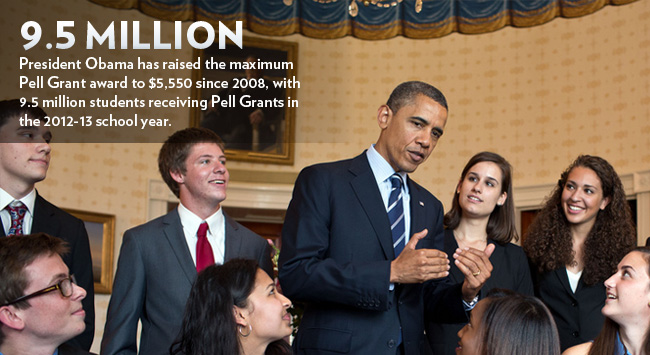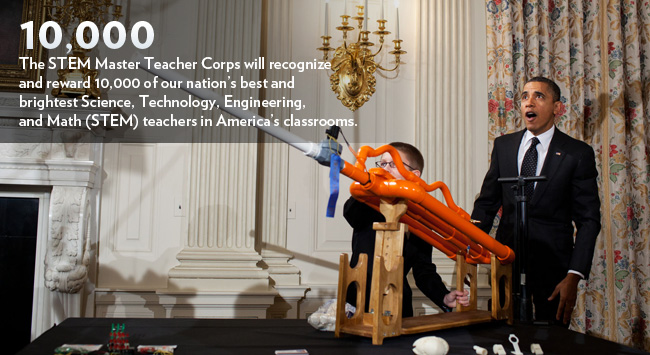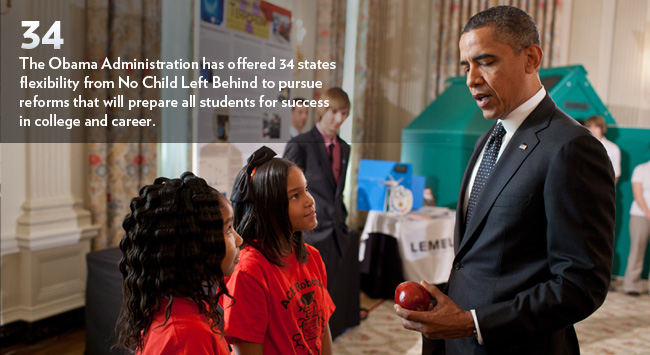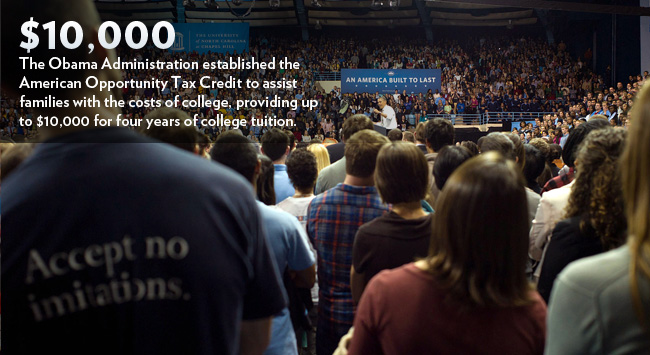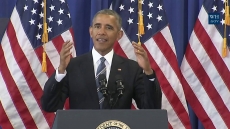EDUCATION
“If we want America to lead in the 21st century, nothing is more important than giving everyone the best education possible — from the day they start preschool to the day they start their career.”
Higher Education
Earning a post-secondary degree or credential is no longer just a pathway to opportunity for a talented few; rather, it is a prerequisite for the growing jobs of the new economy. Over this decade, employment in jobs requiring education beyond a high school diploma will grow more rapidly than employment in jobs that do not; of the 30 fastest growing occupations, more than half require postsecondary education. With the average earnings of college graduates at a level that is twice as high as that of workers with only a high school diploma, higher education is now the clearest pathway into the middle class.
In higher education, the U.S. has been outpaced internationally. In 1990, the U.S. ranked first in the world in four-year degree attainment among 25-34 year olds; today, the U.S. ranks 12th. We also suffer from a college attainment gap, as high school graduates from the wealthiest families in our nation are almost certain to continue on to higher education, while just over half of our high school graduates in the poorest quarter of families attend college. And while more than half of college students graduate within six years, the completion rate for low-income students is around 25 percent.
Acknowledging these factors early in his Administration, President Obama challenged every American to commit to at least one year of higher education or post-secondary training. The President has also set a new goal for the country: that by 2020, America would once again have the highest proportion of college graduates in the world.
To achieve this bold goal for college completion, ensure that America’s students and workers receive the education and training needed for the jobs of today and tomorrow, and provide greater security for the middle class, President Obama and his Administration are working to make college more accessible, affordable, and attainable for all American families.
Helping Middle Class Families Afford College

America is home to the best colleges and universities in the world — and increasing college attainment has never been more important to our economic competitiveness — yet tuition and fees have skyrocketed over the past decade, making it more difficult for American families to invest in a higher education for their future. Today’s college students borrow and rack up more debt than ever before. In 2010, graduates who took out loans left college owing an average of more than $26,000. Student loan debt has now surpassed credit card debt for the first time ever.
Our nation’s commitment to placing a good education within reach of all who are willing to work for it helped build a strong American middle class over the past several generations. In keeping this promise alive, President Obama has expanded federal support to help more students afford college, while calling for a shared responsibility in tackling rising college costs. President Obama’s efforts of reform in higher education funding have produced the largest investment in student aid since the G.I. Bill, while resulting in a more efficient, reliable, and effective system for students to help them afford college and manage debt:
Doubling Investments in Pell Grants
The President has raised the maximum Pell Grant award to $5,730 for the 2014-15 award year — a nearly $1,000 increase since 2008. Under the President’s leadership, the number of Pell Grant recipients has expanded by 50 percent over that same time, providing college access to millions of additional low-income and middle-class students across the country. The Obama Administration’s landmark investment in the Pell Grant was enacted in the Health Care and Education Reconciliation Act of 2010, which ended student loan subsidies for private financial institutions and banks and shifted over $60 billion in savings back to students.
Helping Students Manage Student Loan Debt
The Administration’s “Pay as You Earn” plan expands income-based repayment to enable 1.6 million students to take advantage of a new option to cap repayment of student loans at 10 percent of monthly income — an option that student borrowers can begin to use at the end of this year. These changes will reduce the burden of student loans in a fiscally responsible way. Additionally, millions of borrowers are now eligible to consolidate Direct Loans and FFEL Loans and save up to half a percentage point on their interest rate.
For more information: Everything you need to know about income-based repayment
Expanding Education Tax Credits
President Obama established the American Opportunity Tax Credit in 2009 to assist families with the costs of college, providing up to $10,000 for four years of college tuition for families earning up to $180,000. 11.5 million families are expected to now benefit from the American Opportunity Tax Credit.
Keeping Student Loan Interest Rates Low
In his 2012 State of the Union address, the President called on Congress to keep interest rates low for the 7.4 million borrowers who take out subsidized Federal student loans for this school year. With President Obama’s leadership, rates on new subsidized Stafford loans remained at 3.4 percent — instead of doubling to 6.8 percent — this past summer. This bold action saved students an average of $1,000 on the life of their loans, and President Obama has committed to keeping interest rates low for student loans moving forward.
In August, President Obama signed a bill that takes an important step in fulfilling our nation's obligations to students. The bipartisan legislation cuts rates on all new loans this year and save a typical undergraduate student $1,500 over the life of those loans.
Learn more: Fact Sheet on Bipartisan Student Loan Deal
Strengthening Community Colleges

The President has placed a strong emphasis on making America’s community colleges stronger, ensuring that they are gateways to economic prosperity and educational opportunities for millions of Americans each year. Each year, over 1,100 community colleges provide students and workers with critical skills. To help reach the President’s college attainment goal, the Obama Administration has called for a new partnership with states to ensure that the first two years of community college are free for responsible students, whether they are completing the first half of a bachelor’s degree or earning skills to go directly into the workforce.
In 2010, the President convened the first White House Summit on Community Colleges to focus on the important role these institutions play in our effort to increase the number of college graduates and prepare those graduates to lead the 21st century workforce. The President has demonstrated his commitment to deepening and expanding that work:
America's College Promise
Nearly a century ago, a movement that made high school widely available helped lead to rapid growth in the education and skills training of Americans, driving decades of economic growth and prosperity. Now, President Obama has called for the first two years of community college to be free for responsible students, helping students earn the first half of a bachelor’s degree and earn skills needed in the workforce at no cost.
The America’s College Promise proposal would create a new partnership with states to help them waive tuition in high-quality programs for responsible students, while promoting key reforms to help more students complete at least two years of college. If all states participate, an estimated 9 million students could benefit. A full-time community college student could save an average of $3,800 in tuition per year.
Technical Training for Middle Class Jobs
In January 2015, the President proposed the American Technical Training Fund to award programs that have strong employer partnerships and include work-based learning opportunities, provide accelerated training, and are scheduled to accommodate part-time work. This discretionary budget proposal would fund 100 centers to help high-potential, low-wage workers gain the skills to work into growing fields with significant numbers of middle-class jobs that local employers are trying to fill, such as energy, IT, and advanced manufacturing.
Job-Driven Training Grants
Through the Trade Adjustment Community College and Career Training program more than 1,000 institutions have received $2 billion in federal funding to design education and training programs, working closely with employers and industry that prepare workers for jobs in-demand in their regional economies, such as health care, information technology and energy. These programs have shown early success -- through the end of FY2013, among the nearly 164,000 individuals who had enrolled in these programs 88 percent either completed a program or continued the program into a second year.
Center for the Analysis of Postsecondary Research
In August 2014, the Department of Education launched a new Institute for Education Sciences-funded Center for the Analysis of Postsecondary Readiness (CAPR) that is working to strengthen the research, evaluation, and support of college readiness efforts across the nation. CAPR is documenting current practices in developmental English and math education to identify innovative instructional practices that improve student success.
Keeping Costs Down

The President is calling on Congress to advance new reforms to give more hard working students a fair shot at pursuing higher education, because education is not a luxury: it is an economic imperative that every hard working and responsible student should be able to afford. President Obama has emphasized that the federal government, states, colleges, and universities all have a role to play in making higher education more affordable, by reining in college costs, providing value for American families, and preparing students with a solid education to succeed in their careers.
In his State of the Union address, President Obama emphasized this shared responsibility of states and higher education institutions — working with the federal government — to promote access, affordability and attainment in higher education by reining in college costs, providing value for American families, and preparing students with a high quality education to succeed in their careers. It is not enough to increase federal student aid alone — state policymakers and individual colleges and universities bear a shared responsibility to take action against rising college tuition and costs.
Providing greater pathways for students to enter into and succeed in higher education is in the interest of all Americans, and is critical to developing a highly educated, highly skilled economy and workforce that will attract business and lead to lower unemployment. The Administration has taken several steps and advanced several proposals to put higher education greater within reach for more Americans:
Reforming student aid to promote affordability and value
To keep tuition from spiraling too high and drive greater value, the President has proposed reforms to federal campus-based aid programs to shift aid away from colleges that fail to keep net tuition down, and toward those colleges and universities that do their fair share to keep tuition affordable, provide good value, and serve needy students well. These changes in federal aid to campuses will leverage $10 billion annually to help keep tuition down.
Creating a Race to the Top for college affordability and completion
The President has proposed incentives for states to maintain their commitments to higher education through a new $1 billion investment. The Race to the Top: College Affordability and Completion challenge aims to increase the number of college graduates and contain the cost of tuition by rewarding states that are willing to systematically change their higher education policies and practices.
Kicking off a First in the World competition
The President is proposing an investment of $55 million in a new First in the World competition, to support public and private colleges and non-profit organizations as they work to develop and test the next breakthrough strategy that will boost higher education attainment and student outcome, while leading to reduced costs.
Improving Transparency and Accountability

President Obama has consistently strived to lead the most open, efficient and accountable government in history. Over the last two years, new initiatives have increased public participation in government, opened up new information to Americans on a variety of topics, and improved citizens' everyday lives. In the vein of transparency and accountability, the President tasked his Administration with giving students and families new tools and relevant information that will help them make sound financial decisions in pursuing their higher education goals.
Creating a Financial Aid Shopping Sheet
The Department of Education and the Consumer Financial Protection Bureau have launched the “Know Before You Owe” campaign to create a model financial aid disclosure form — the Financial Aid Shopping Sheet — to help students better understand the type and amount of aid they qualify for and easily compare aid packages offered by different colleges and universities. The Financial Aid Shopping Sheet is an individualized standard financial aid award letter that will help students and families understand the costs of college before making the final decision on where to enroll. The Shopping Sheet is being voluntarily adopted by colleges and universities across the country for the 2013-14 academic year to provide students and families with critical information about their financial decision to attend college in a clear, concise, and standardized format that facilitates easy comparisons across institutions.
Launching the College Scorecard
As part of the President's commitment to help students, parents, and their advisers make better college choices, the Department of Education has launched its new College Scorecard to support students and families as they search for and select a college suitable to their academic and career goals. The new College Scorecard is designed with direct input from students, parents, counselors, and others to ensure they have access to user-friendly, easy-to-understand information on college opportunity, cost, and value. This tool is built from the most comprehensive and reliable data on all higher education institutions, which for the first time include students' earnings, graduates' debt, and borrowers' repayment rates. These data are open to the public, making it possible for anyone - student, school, policymaker or researcher - to learn about college performance. Better information will help students choose where they are likely to learn, graduate, and find jobs. Better information will help colleges understand how well they are serving their students. Better information can unite students, parents, advisors, policymakers, and institutions on goals to lower costs and help more students graduate. You can learn more here.
Protecting Our Veterans, Military Spouses, and their Families
President Obama’s Executive Order Establishing Principles of Excellence for Educational Institutions Serving Service Members, Veterans, Spouses, and Other Family Members provides new protections for our nation’s military, veterans, and their families to help ensure they have the information they need to succeed in higher education. The Principles of Excellence — which will apply to a variety of military and veteran education benefits, including the GI Bill, Tuition Assistance Program, and Military Spouse Career Advancement Account Program (MyCAA) — cracks down on improper online recruiting practices, improve support service, provide better data on educational institutions, and strengthen enforcement of student protections. The President believes we must do all we can administratively to protect veterans from these deceptive practices by improving the quality of information and services that these schools must provide, and these steps will help ensure that Federal military and veteran education dollars are well spent.
